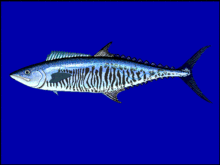Narrow-barred Spanish mackerel
| Narrow-barred Spanish mackerel | |
|---|---|
 |
|
| Scientific classification | |
| Kingdom: | Animalia |
| Phylum: | Chordata |
| Class: | Actinopterygii |
| Order: | Perciformes |
| Family: | Scombridae |
| Genus: | Scomberomorus |
| Species: | S. commerson |
| Binomial name | |
|
Scomberomorus commerson (Lacépède, 1800) |
|
The narrow-barred Spanish mackerel (Scomberomorus commerson) is a mackerel of the Scombridae family found in a wide-ranging area centering in Southeast Asia, but as far west as the east coast of Africa and from the Middle East and along the northern coastal areas of the Indian Ocean, and as far east as the South West Pacific Ocean.
They are vivid blue to dark grey in colour along their backs and flanks and fade to a silvery blue-grey on the belly. Spanish mackerel have scores of narrow, vertical lines down their sides. Spanish mackerel are the largest of all Australian mackerels, growing to about 200 cm and up to 70 kg.
It is found in a wide area centering in Southeast Asia, but as far west as the east coast of Africa and from the Persian Gulf and along the northern coastal areas of the Indian Ocean, and as far east as Fiji in the South West Pacific ocean. They are common down both sides of Australia as far south as Perth on the west coast and Sydney on the east coast. They are also found as far north as China and even Japan.. It has colonised the Mediterranean as a Lessepsian migrant from the Red Sea through the Suez Canal, being first recorded off Palestine in the 1930s and it is now common in the eastern Mediterranean, having become an important quarry species for local fisheries.
Spanish mackerel spawn in oceanic conditions on reef edges. Eggs have a large oil droplet that aids in buoyancy and keeps them at the top of the water column which is warmer, well oxygenated, and has an abundant planktonic food supply for the larvae once they are hatched. When in the larval stage, Spanish mackerel are believed to stay in their own species-specific groups and are not normally found with other species of the same genus, such as S. semifasciatus and S. queenslandicus. This is not always the case with adult mackerel, where occasional mixing of different species within the same genus can occur.
...
Wikipedia

